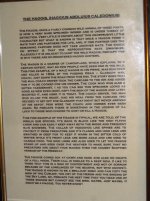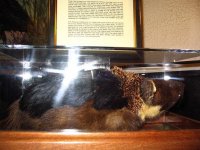AndrewT said:I got 0.2mV output offset.
The input pair are thermally coupled and bound with three turns 0.5mm diameter copper wire.
The output emitter resistors are matched to <0.5%.
Measuring output or bias currents through unknown or loose tolerance resistors is a complete waste of time and effort.
I suspect that the remaining offset might be due to the SC/SA pairs, as I didn't have overlap between the 2SCy and 2SAo. I got them as close as I could. I'm guessing this, because all four channels have similar offset, and positive in all cases (unlikely due to random mismatch in the input pairs).
My output emitter resistors are 1%. I didn't measure them as my meter isn't reliable at such low resistance (and I was too lazy to cobble together a current source), so I'm trusting the specifications. However, even 5% error means, well, 5% error in current measurement, which is 1mV out of 20. If I'm within 1mV I'm happy. All other resistors are 1%, and I did measure those. I think I can be pretty certain that the variation is not resistor tolerance.
Sheldon
I think you should be fairly sure that almost half the measured variation between the output transistor bias is down to resistor tolerance.Sheldon said:I think I can be pretty certain that the variation is not resistor tolerance.
The output offset is hardly affected by the output stage.
It is mostly created in the input LTP and the mirrored second stage.
AndrewT said:I think you should be fairly sure that almost half the measured variation between the output transistor bias is down to resistor tolerance.
The output offset is hardly affected by the output stage.
It is mostly created in the input LTP and the mirrored second stage.
OK, I'm not fully convinced, but open. Can't be in the emitter resistors, as that would have a one to one error relationship, and those are 1% resistors. If it is other resistors, wherein the error is amplified, then which ones (R15-18?)? That's not a rhetorical question. Because, if I can identify the sensitive component, I can make a small adjustment.
Sheldon
adjusting r16 from a close match with r17 (was 150r, now 139r5) is completely ignoring the designers advice on matching the pairs of active devices.
Before you added the 2k0, what were the voltages across r16 & r17?
Similarly, what were the voltages across r15 & r18?
What is the voltage across the FET gates?
Before you added the 2k0, what were the voltages across r16 & r17?
Similarly, what were the voltages across r15 & r18?
What is the voltage across the FET gates?
I didn't ignore the designer's advice at all. In fact, I've tried to follow it to the letter. I matched devices as well as I could. And I've made no permanent changes, just clipping in resistors. As for measurements across the resistors: R15 - 1.280, R18 - 1.279, R16 - 0.355, R17 - 0.357, J1-J2 - 5mV.
BTW, 10k in parallel with R15 (148R) zero's out the offset.
Sheldon
BTW, 10k in parallel with R15 (148R) zero's out the offset.
Sheldon
roender said:The offset doesn't mater, do not argue anymore, please try to listen to some music through the amplifier instead. Life is so short ...
Mihai,
I don't like to argue. I was asking honest questions out of curiosity. No one is required to answer them, if they don't want to. But I did want to set the record straight, so that it's understood that I'm not trying to redesign or "improve" this amp, but merely understand how to tune it. Most of my other projects are simpler tube amps, and for those I do like to put my own stamp on the design, even if it's little things. This amp is too complicated for me to get involved in circuit changes.
Part of the reason (the biggest part) I build anything, is that I like learning about new things. And I like to know how things work (at the hobby level, I've built engines, suspensions, guitars, furniture, speakers, parts of homes, gardens, you name it). I seriously doubt that the tinkering with offset will be audible at all to me, but that's not the point. I'm not anywhere near as knowledgeable about these circuits as you, Andrew, or most of the others on this thread. But I do have a good understanding of basic logic, and I like to apply that to what I am building to see if I can understand it better. So if I can poke and prod a bit, I begin to get some sense of the quantitative nature of the various relationships among the circuit elements. I could do the most of the same by simulation, but it would take me longer to master that than it does just to do a few simple experiments on the live circuit.
Thanks for your design and all your help, and others here too, including Andrew. I've got a little to finish on the case, then it's off to get anodized, then some serious listening.
Sheldon
edit: spelling
Sheldon said:
Thanks for your design and all your help, and other here too, including Andrew. I've got a little to finish on the case, then it's off to get anodized, then some serious listening.
Sheldon
Thanks for your trust in my design.
As I specified in the first post, RMI-FC100 is the end of my journey in designing power audio amplifiers, that's because it sound so good
It was (and is) my pleasure to share with all of you.
Regards,
Mihai
AKSA said:Most designers can't help themselves, they are drawn to it, like moths to a flame......
Ain't that the truth. Just like I'm a sucker for things that strike me as being cool. I need another amp like I need a hole in the head, but here I am building one (actually two stereo amps)- and not a cheap trivial build either. BTW, you are partially to blame for that, given your enthusiastic response.
Sheldon
p.s. Actually the moth thing is pretty cool. They are not drawn to a flame directly. They evolved in a world where light came from celestial objects. In order to navigate in a specific direction they maintain a fixed angle between their direction and a light source. Works pretty well with objects that are very distant. With closer objects, it means that they spiral in toward the object.
AKSA said:That angle is 80 degrees, and I believe it creates a Fibonacci spiral?
You're evil Hugh. Now I gotta go look that up.
Sheldon
AKSA said:Mihai,
But perhaps there are other designs lurking in your head, no?
Most designers can't help themselves, they are drawn to it, like moths to a flame......
Hugh
Hi Hugh,
I have listened to other topologies, most of them with less or equal sound quality compared with differential folded cascode design.
My decision to stop searching for “new” topologies is rather philosophically than emotionally taken. Why should I invest more precious lifetime in something very time consuming than live my life and enjoy what I’ve already achieved?
If I would ever try something new in this field, it will be bases on the same folded cascade design but with better components, which will be available in the future.
I'm not a pro, so I am not forced to continuously develop something new, which is not always better
There are so many other things I would like to do and there is no guaranty that mighty sun will raise tomorrow...
Regards,
Mihai
roender said:a very rare animal
Rare indeed, the ones found always look like roadkill.
A vegetarian rodent, so i gathered, and they appear to enjoy oatmeal a great deal.

(Nasty stuff, just the thought of youth oatmeal porridge days runs shivers down my spine.)
I swear I saw a haggis! 
"According to one poll, 33% of American visitors to Scotland believe haggis to be an animal." http://en.wikipedia.org/wiki/Haggis

"According to one poll, 33% of American visitors to Scotland believe haggis to be an animal." http://en.wikipedia.org/wiki/Haggis
Attachments
jacco vermeulen said:
Rare indeed, the ones found always look like roadkill.
A vegetarian rodent, so i gathered, and they appear to enjoy oatmeal a great deal.
(Nasty stuff, just the thought of youth oatmeal porridge days runs shivers down my spine.)
Jacco,
I swear I saw a haggis!

"According to one poll, 33% of American visitors to Scotland believe haggis to be an animal." http://en.wikipedia.org/wiki/Haggis
- Home
- Amplifiers
- Solid State
- RMI-FC100, a single stage audio power amplifier



